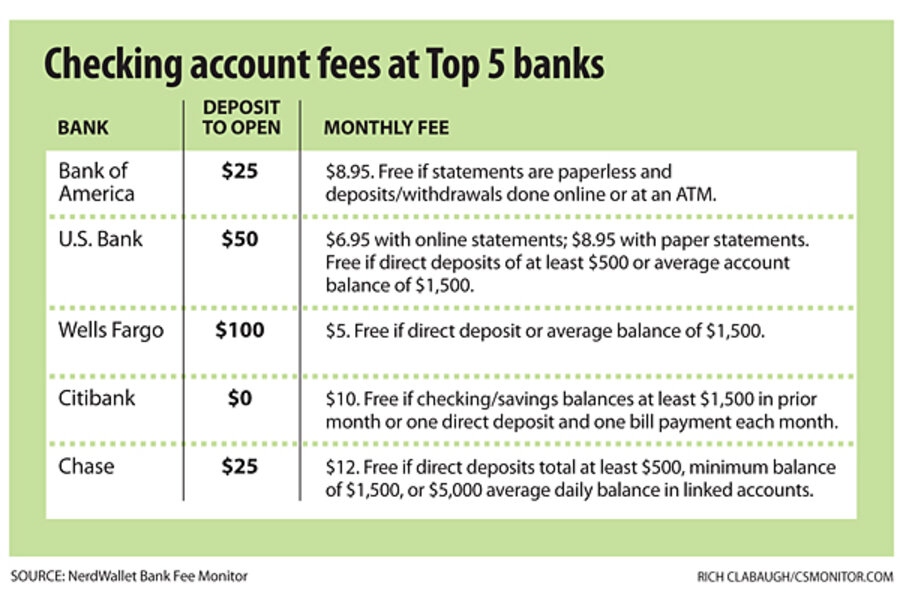Bye-bye free checking. Hello fee checking.
Loading...
The Consumer Financial Protection Bureau is now accepting consumers’ complaints about bank accounts, including issues related to withdrawing money, making payments and using debit and ATM cards.
The CFPB’s announcement last week followed closely news that Bank of America is experimenting with a new system that would levy monthly fees on users of basic checking accounts. As if its botched attempt to introduce a $5 debit-card charge last fall wasn’t enough, this latest move could trigger another consumer uprising and a tidal wave of criticism.
It’s also causing people to wonder, is free checking becoming a thing of the past? And if so, what role will the CFPB play in regulating fees?
All of the largest banks offered free checking until 2009, Mike Moebs, founder of financial research company Moebs $ervices Inc, told the Huffington Post. Now, almost none do. And as free checking has dwindled, checking service fees have shot up. Javelin Strategy & Research recently released a study tracking the rise in bank fees for checking accounts over the past 10 years. The report, which included data from both large and small banks, estimated that consumers now pay 26 percent more in checking account fees than in 2002, and that larger banks typically charge higher fees.
Since it abolished its $5 debit-card charge, Bank of America has been testing the checking account fees in Arizona, Georgia, and Massachusetts with monthly charges of $6 to $9 for customers with “Essentials” accounts. Other account options being tested are charging monthly fees ranging from $9 to $25, but they also give customers the chance to get the charges waived if they use a credit card, take a mortgage with Bank of America, or maintain a minimum balance in their accounts. (To see how checking account fees stack up at the five biggest banks, click the chart above.)
If checking used to be free, why are the big banks charging now?
The fees mark a sign of stress in the banking industry during a time of historically low interest rates and sluggish economic growth. Plus, the banks got slammed with regulatory rules in 2009 and 2010 that curtailed traditional bank fees, halved what they could charge merchants for taking credit and debit cards, and prohibited them from automatically enrolling checking account customers in services that charged for overdrafts.
Banks need to find a way to make up for the billions of dollars lost in revenue. Bank of America and others tried to do that by establishing monthly fees for making debit-card purchases, but they quickly backpedaled when customers revolted.
After the $5 debit-card fee fiasco, banks are finding it harder than ever to implement changes.
J.P. Morgan consumer banking chief Todd Maclin told investors recently that the bank would like to be able to charge more than $10 to $12 a month, according to The Wall Street Journal, but “in this environment I am not going to rock that boat.” (In the last few months, the bank has eliminated or trimmed other less-common fees for things like account research, copies of documents, and account closures.)
In the current hostile climate, banks are beginning to get sneakier about raising fees. So, instead of levying a flat $5 debit-card charge, Bank of America is targeting its checking account users.
Since almost 9 in 10 Americans have a checking account, according to the CFPB, charging for checking could be a profitable move for banks. Mr. Moebs said that Bank of America’s new fee system would affect a broader swath of its consumer base than the debit-card charges.
Checking account fees will not only hit more consumers, but will “particularly impact the most vulnerable, who have the least capacity to meet minimum balances and avoid the fees,” Norma Garcia, senior attorney at Consumers Union, told the Huffington Post. In a press release, she urged Bank of America to drop its latest fee scheme, or “risk losing even more consumers who are tired of being nickeled and dimed at every turn.”
As much as we hated the idea of the $5 debit-card charge, at least Bank of America was up-front about the flat fee. It’s still being tested, but this new system for checking-account charges seems much more complicated, requiring customers to maintain certain minimum balance, use a credit card, or take a mortgage to dodge the fees. Plus, as some consumer advocates believe, it seems targeted to hit those who need free checking accounts the most.
Banking fees should not be “punitive,” meant to trap customers in problems, Kathleen Day, spokesman for the Center for Responsible Lending, told Bloomberg/Businessweek. She cited high-interest payday loans and overdraft charges as examples of these punitive fees that “pound customers into the ground.” However, Ms. Day said she also sympathizes with Bank of America, which does not offer either payday loans or overdraft fees and had to give up its $5 debit-card fee. “You could argue that it is a more transparent pricing mechanism,” she said.
The checking account fee system in the works may be less transparent than a flat debit-card charge, but this is where the CFPB can step in. Already, the CFPB has announced its plans to examine how banks charge overdraft fees to customers who bounce checks or withdraw more than they have in their accounts using debit cards or ATMs.
“Overdraft practices have the capacity to inflict serious economic harm on the people who can least afford it,” said CFPB Director Richard Cordray. “We want to learn how consumers are affected, and how well they are able to anticipate and avoid paying penalty fees.”
Now, with these new checking account charges under development, and the CFPB’s recent announcement to take on complaints about bank accounts, it seems that it is taking its job as a watchdog seriously – although it’s too soon to judge its bite.
It’s certainly getting an earful, anyway. As of Feb. 22, the Bureau says that it has received more than 20,000 complaints, including nearly 7,000 on mortgages and almost 12,000 on credit cards.
– Tim Chen is the CEO and chief credit card analyst at NerdWallet.com, a site that educates consumers about credit cards.







